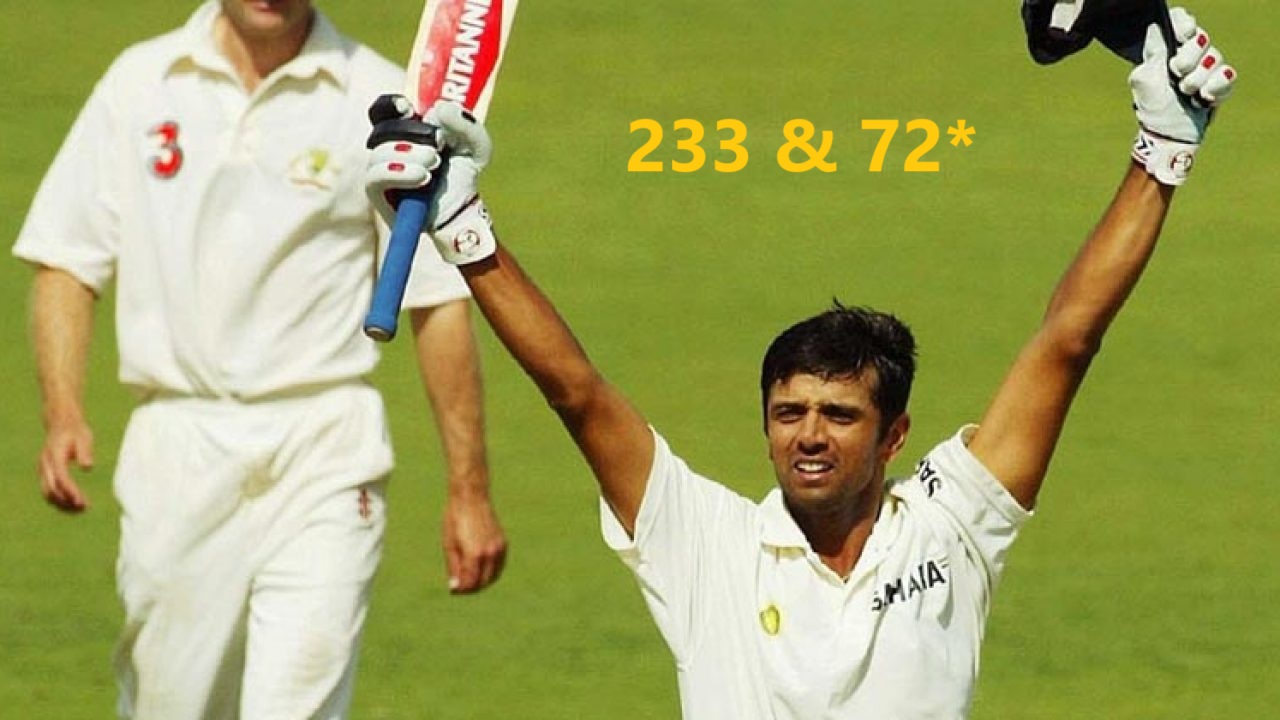Welcome to Episode 1 of The Border Gavaskar Trophy: Moments of Glory, where we revisit the most iconic moments from this fierce rivalry. In today’s episode, we highlight a memorable and hard fought innings by Rahul Dravid, as he scored a brilliant 233.
Rahul Dravid, the “Indian Wall,” is undeniably one of the finest Test batsmen ever. Time and again, he has stood firm when India needed him the most, delivering under pressure and anchoring the team through some of its toughest battles.
The Border Gavaskar Trophy 2000-2001 was meant to be a defining moment in Indian cricket. India, under the captaincy of Sourav Ganguly, was brimming with optimism. The team had recently beaten Zimbabwe and South Africa at home, and there was a sense that they were on the rise. Australia, however, was a different beast altogether. Steve Waugh’s men, with their unrelenting aggression, had dominated world cricket for years.
India’s challenge was clear: they had to prove themselves against the world’s best.
The first Test at The Gabba in Brisbane ended in a draw, which felt like a modest victory for India, given that The Gabba has long been a fortress for Australia. India built a significant first-innings lead, thanks in large part to an aggressive century from captain Sourav Ganguly, who scored a remarkable 144 runs off just 196 balls.
The atmosphere was charged with anticipation as both teams arrived at The Adelaide Oval, each determined to seize the upper hand in the series. Australia, looking to make a statement, won the toss and opted to bat first. With the pitch offering ideal conditions for batting, the hosts had one clear objective: to post a colossal total that would place the visiting side firmly under pressure. The stage was set for a thrilling contest, and Australia was ready to take full advantage of the opportunity.
December 12, 2003 – The Adelaide Oval, Adelaide
Australia began their innings with caution but soon unleashed a brutal assault on the Indian bowling attack, led by captain Ricky Ponting, who played one of his finest knocks, scoring an exceptional 242 runs. The Australian side finished with a mammoth total of 556 runs in their first innings. For India, Anil Kumble was the standout bowler, claiming 5 wickets for 154 runs. With Australia setting a daunting target, the pressure was now on India’s top order to mount a strong and determined response.
Indian openers Virender Sehwag and Akash Chopra launched a spirited fightback, putting together a brisk 61-run partnership in just 12 overs, with Sehwag contributing the lion’s share of the runs. The stand was broken by Bichel and Chopra was sent packing. This brought Rahul Dravid to the crease, who had his own intentions of taking on the Australian attack. What followed at The Oval would soon unfold as one of the greatest innings in cricket history, a performance that would leave an indelible mark on the game.
India quickly found themselves in trouble, losing three quick wickets—Virender Sehwag, Sachin Tendulkar, and Saurav Ganguly, the centurion from the previous match—to be reduced to 4 for 85. Once again, the responsibility fell on Rahul Dravid to steer India out of the crisis. He was joined at the crease by the stylish and elegant VVS Laxman, with both knowing the magnitude of the challenge ahead.
The Calm Before the Storm: Dravid’s Silent Resolve
Dravid, who had often been India’s rock, now had a new task before him. This wasn’t about playing for personal milestones or glory. This was about saving the match. The reputation of Indian cricket was hanging by a thread. With his calm demeanor and relentless focus, Dravid began to build what would become one of the most memorable innings in cricket history.
At the other end stood VVS Laxman, an elegant stroke-maker who had a gift for silencing his critics when he was in the mood. The two men were about to forge a partnership that would rewrite the history books.

The Defiance Turns into Dominance: Dravid’s 100
As the innings progressed, it became clear that the Indian batsmen were not ready to give up that easily. Dravid, having faced Australia’s world-class bowling attack in the first Test, was now determined to show that India could fight back. He was the perfect foil to Laxman’s stylish aggression, playing a steady hand in the face of McGrath’s precision and Warne’s spinning wizardry.
Every ball that passed seemed to be a test of endurance. But Dravid—methodical and unwavering—was in his element. The runs came slowly at first. A couple of drives to the boundary, a few well-timed cuts and pulls, but mostly a series of tight defenses and unhurried leaves.
By the time Dravid brought up his century, the mood in the stands had shifted. What was once doubt was now hope. True to their fighting spirit, the Australians relentlessly sought to find their rhythm and break the growing partnership. The Indians weren’t just surviving; they were fighting, and the fight was becoming a war that they were determined to win.
The Moment of Glory: Dravid’s 233
Dravid’s 233 wasn’t just a century or a double century—it was a defiance of everything that had gone wrong for him personally in the previous Test where he could only score 1 and 43*. It was a stand against the mounting pressure, a display of composure and skill that would go down as one of the greatest innings in the history of Test cricket.
Every run that came off Dravid’s bat felt like a victory. Every ball he left, every stroke he played, was a message to the Australians that they had met their match. With Laxman’s 148 at the other end, the partnership between the two was nothing short of extraordinary. Together, they had put on 303 runs, turning the match on its head.

When Laxman was dismissed, the duo had batted for almost 94 overs. Their partnership had not only salvaged the match but had also put India in a strong position to challenge Australia’s first-innings total. Rahul Dravid, the last man to fall, had scored a monumental 233 runs, batting for nearly 74 overs. Thanks to his marathon innings, India posted 523 runs, just 33 runs short of Australia’s total.
India went on to win the Test by 6 wickets, with Rahul Dravid once again anchoring the chase. He remained unbeaten on 72, guiding India to victory and ensuring his pivotal role in the win. It wasn’t just a victory on the scoreboard; it was a victory for Indian cricket, for the spirit of the team, and for the belief that anything was possible in Test cricket. Dravid’s 233 was the bedrock upon which India’s historic win was built. It was a testament to the resilience and skill of a man who was often overshadowed by flashier, more aggressive players but who, on that day, proved that true greatness lies in the ability to fight when it matters the most.
Dravid’s 233 became a turning point in India’s cricketing history. The match, and his performance in it, laid the foundation for what would later become a period of dominance for India, especially in Test cricket. From that moment, India had arrived..
Also read,
